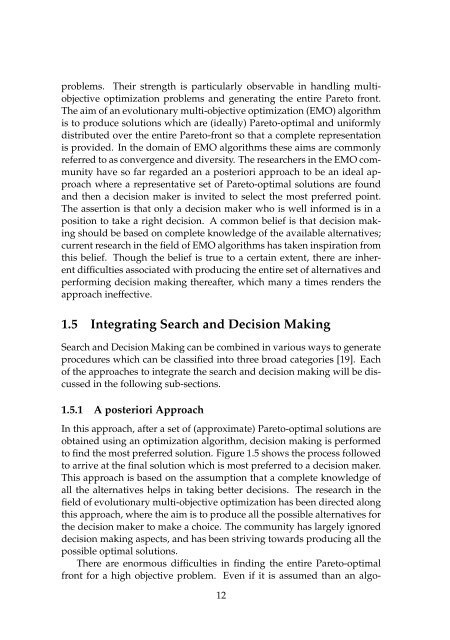Progressively Interactive Evolutionary Multi-Objective Optimization ...
Progressively Interactive Evolutionary Multi-Objective Optimization ...
Progressively Interactive Evolutionary Multi-Objective Optimization ...
You also want an ePaper? Increase the reach of your titles
YUMPU automatically turns print PDFs into web optimized ePapers that Google loves.
problems. Their strength is particularly observable in handling multiobjective<br />
optimization problems and generating the entire Pareto front.<br />
The aim of an evolutionary multi-objective optimization (EMO) algorithm<br />
is to produce solutions which are (ideally) Pareto-optimal and uniformly<br />
distributed over the entire Pareto-front so that a complete representation<br />
is provided. In the domain of EMO algorithms these aims are commonly<br />
referred to as convergence and diversity. The researchers in the EMO community<br />
have so far regarded an a posteriori approach to be an ideal approach<br />
where a representative set of Pareto-optimal solutions are found<br />
and then a decision maker is invited to select the most preferred point.<br />
The assertion is that only a decision maker who is well informed is in a<br />
position to take a right decision. A common belief is that decision making<br />
should be based on complete knowledge of the available alternatives;<br />
current research in the field of EMO algorithms has taken inspiration from<br />
this belief. Though the belief is true to a certain extent, there are inherent<br />
difficulties associated with producing the entire set of alternatives and<br />
performing decision making thereafter, which many a times renders the<br />
approach ineffective.<br />
1.5 Integrating Search and Decision Making<br />
Search and Decision Making can be combined in various ways to generate<br />
procedures which can be classified into three broad categories [19]. Each<br />
of the approaches to integrate the search and decision making will be discussed<br />
in the following sub-sections.<br />
1.5.1 A posteriori Approach<br />
In this approach, after a set of (approximate) Pareto-optimal solutions are<br />
obtained using an optimization algorithm, decision making is performed<br />
to find the most preferred solution. Figure 1.5 shows the process followed<br />
to arrive at the final solution which is most preferred to a decision maker.<br />
This approach is based on the assumption that a complete knowledge of<br />
all the alternatives helps in taking better decisions. The research in the<br />
field of evolutionary multi-objective optimization has been directed along<br />
this approach, where the aim is to produce all the possible alternatives for<br />
the decision maker to make a choice. The community has largely ignored<br />
decision making aspects, and has been striving towards producing all the<br />
possible optimal solutions.<br />
There are enormous difficulties in finding the entire Pareto-optimal<br />
front for a high objective problem. Even if it is assumed than an algo-<br />
12
















